
What's Opera, Doc? is a 1957 American Warner Bros. Merrie Melodies cartoon directed by Chuck Jones and written by Michael Maltese. The short was released on July 6, 1957, and stars Bugs Bunny and Elmer Fudd.

The Big Snooze is a 1946 Warner Bros. Looney Tunes cartoon planned by Bob Clampett and finished by Arthur Davis, who were both uncredited as directors. It features Bugs Bunny and Elmer Fudd, voiced by Mel Blanc and Arthur Q. Bryan.

A Wild Hare is a 1940 American animated comedy short film directed by Tex Avery, produced by Leon Schlesinger, and distributed by Warner Bros. as part of the Merrie Melodies series. The film was released on July 27, 1940, and features Elmer Fudd and Bugs Bunny, the latter making what is considered his first official appearance.
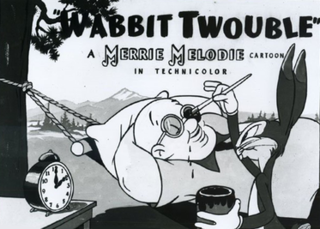
Wabbit Twouble is a Merrie Melodies cartoon starring Bugs Bunny, produced by Leon Schlesinger Productions and released on December 20, 1941, by Warner Bros. Pictures.

Elmer's Candid Camera is a 1940 Warner Bros. Merrie Melodies cartoon short directed by Chuck Jones. The short was released on March 2, 1940, and features Elmer Fudd and an early Bugs Bunny prototype.
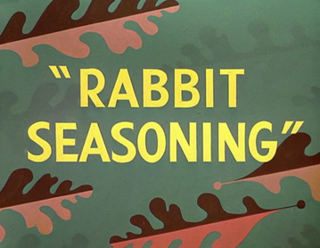
Rabbit Seasoning is a 1952 Warner Bros. Merrie Melodies cartoon directed by Chuck Jones. Released on September 20, 1952, the short stars Bugs Bunny, Daffy Duck and Elmer Fudd.
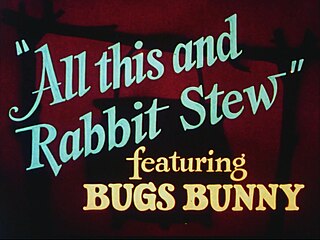
All This and Rabbit Stew is a 1941 Merrie Melodies cartoon directed by Tex Avery. The cartoon was released on September 13, 1941, and features Bugs Bunny.

The Old Grey Hare is a 1944 Merrie Melodies cartoon directed by Bob Clampett. The short was released on October 28, 1944, and features Bugs Bunny and Elmer Fudd, voiced by Mel Blanc and Arthur Q. Bryan respectively.

The Wabbit Who Came to Supper is a 1942 Merrie Melodies cartoon featuring Bugs Bunny and Elmer Fudd. It was released on March 28, 1942, and directed by Friz Freleng.

Easter Yeggs is a 1947 Looney Tunes theatrical animated short. The cartoon was released on June 28, 1947, and features Bugs Bunny and Elmer Fudd. The title is a play on "Easter eggs" and on "yegg", a slang term for a burglar or safecracker. The voice and characterization of the Easter Bunny in the short is a reference to a character that Mel Blanc performed on the Burns and Allen radio show, the morose Happy Postman, even including the character's catch phrase, "Remember, keep smiling."

Hare Remover is a Merrie Melodies cartoon starring Bugs Bunny and Elmer Fudd, released in 1946. The film was the second Bugs Bunny cartoon to be directed by Frank Tashlin, the first being The Unruly Hare (1945).
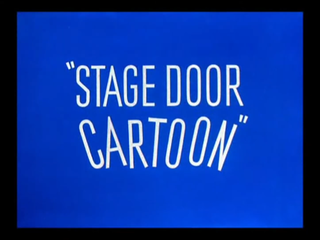
Stage Door Cartoon is a 1944 Merrie Melodies cartoon directed by Friz Freleng. The short was released on December 30, 1944, and features Bugs Bunny and Elmer Fudd.
The Unruly Hare is a 1945 Warner Bros. cartoon in the Merrie Melodies series directed by Frank Tashlin and written by Melvin Millar. The cartoon was released on February 10, 1945 and stars Bugs Bunny and Elmer Fudd. The film was one of only two Bugs Bunny cartoons directed by Frank Tashlin at Warner Bros., the other being 1946's Hare Remover.

Hare Conditioned is a 1945 Warner Bros. cartoon in the Looney Tunes series. It was directed by Chuck Jones.
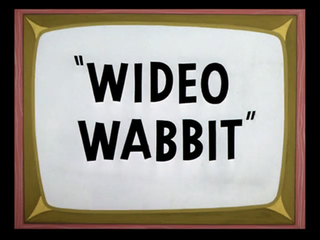
Wideo Wabbit is a 1956 Warner Bros. Looney Tunes cartoon directed by Robert McKimson. The short was released on October 27, 1956, and stars Bugs Bunny and Elmer Fudd. In the film, Bugs volunteers for an appearance in a television show hosted by Elmer. He is unaware that this is a show about hunting techniques, and he volunteers to become a hunter's prey.
Robot Rabbit is a 1953 Warner Bros. Looney Tunes cartoon directed by Friz Freleng. The short was released on December 12, 1953, and stars Bugs Bunny and Elmer Fudd.

Elmer J. Fudd is an animated cartoon character in the Warner Bros. Looney Tunes/Merrie Melodies series and the archenemy of Bugs Bunny. His aim is to hunt Bugs, but he usually ends up seriously injuring himself and other antagonizing characters. He speaks in an unusual way, replacing his Rs and Ls with Ws, so he often refers to Bugs Bunny as a "scwewy" (screwy) or "wascawwy (rascally) wabbit". Elmer's signature catchphrase is, "Shhh. Be vewy vewy quiet, I'm hunting wabbits", as well as his trademark laughter.
The character that would evolve into Bugs Bunny appeared in four cartoon shorts before his first official appearance in Tex Avery's A Wild Hare. While this early version is commonly referred to as "Happy Rabbit", animation historian David Gerstein disputes this, saying that the only usage of the term was from Mel Blanc himself; the name "Bugs Bunny" was used as early as April 1938, from a model sheet made by Charles Thorson which was used for the short Hare-um Scare-um. Bugs was also mentioned by name from an August 1939 review of the short in the Motion Picture Herald.
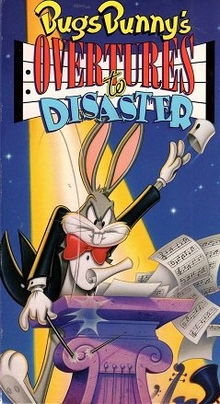
Bugs Bunny's Overtures to Disaster is a Looney Tunes television special directed by Greg Ford and Terry Lennon. In new animation, Jeff Bergman voiced Bugs, Daffy, Porky, Elmer and Sylvester. The special first aired on April 17, 1991 on CBS.















